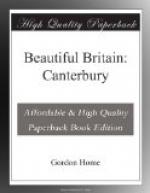The eastern extension of the chapel is called Becket’s Crown, a name tradition associates with the preservation in this chapel of a portion of St. Thomas’s skull. One window contains old glass, and in the centre of the floor is placed the chair of Purbeck marble in which the Archbishops are enthroned. As it is no longer considered as old as the days of Augustine the title St. Augustine’s Chair must be regarded as a figure of speech.
By the most marvellous good fortune the wonderful series of windows in Trinity Chapel, illustrating the many cures wrought at the Shrine of St. Thomas, have come down to the present time almost unharmed, and this magnificent range of thirteenth-century glass is finer than anything else of its period in England. This glass is all prior to 1220, and without it there would have been no representation of the first shrine at all. The colour in these windows is all subservient to the careful drawing of the pictures in the medallions, but in the north choir aisle there are some windows almost of the same period where the colour is as splendid as in any of the early windows at Chartres. For any description of the tombs of the archbishops there is, unfortunately, no space here. In the splendid crypt, besides the interest of the various periods of Norman and Transitional work, there is the rich Perpendicular screenwork of the Chapel of Our Lady of the Undercroft, and the Huguenot Chapel in what was the Black Prince’s Chantry. In Tudor times the whole of the undercroft was given up to the French Protestant refugees, who, besides worshipping there, set up their looms in this hallowed portion of the Cathedral where the martyr was laid until his translation in 1220 and where Henry II. had passed the night after his severe penance. This very short description of such a building must be regarded as a mere introduction to the study of a vast subject, for in the space available nothing more is remotely possible.
CHAPTER IV
THE CITY
A walled city generally holds more easily that elusive quality of romance for which the intelligent mind so often hungers than a town that has long ago discarded its old tower-studded girdle. And among the half-dozen or more English towns still possessed of their old mural defences Canterbury holds a high place, because within its walls there are still, in spite of railways and motors and the horrors of twentieth-century advertising, a hundred byways and nooks where the atmosphere of Elizabethan and pre-Reformation England still lurks. The wall itself does not stand out with the splendid completeness of York or Conway, and on the western side it has vanished altogether, while of the seven or eight gates, one only—the West Gate—has been saved; yet, while walking in the narrow, picturesque streets, it is difficult to forget that Canterbury is a walled city. Until well into last century all the gates were standing; but one by one these ornaments




